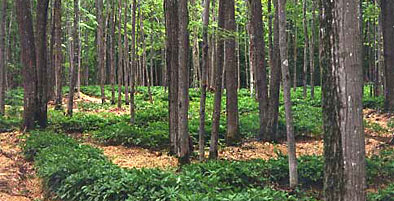Steve Gabriel, co-author of Farming the Woods and eXtension aide at Cornell University, introduces the practice of totem inoculation for forest farming mushrooms. Oyster mushrooms and lion’s mane can be grown on various hardwood species beneath the shade of the forest’s canopy as they are typically found in nature. Lion’s mane prefers to grow on sugar maple and American Beech while oyster mushrooms will colonize a variety of hardwoods including cottonwood, box elder, and tulip poplar, to name a few. Stropharia prefers growing in a bed of wood chips and saw dust where they can make contact with the duff layer and draw moisture from the soil.
Growing lion’s mane or oyster mushrooms on totems requires hardwood logs; sugar maple and American beech for lion’s mane, and a variety of softer hardwoods such as cottenwood, box elder, and poplar for oyster mushrooms. Spawn comes in two varieties for lions mane, Hericium erinaceous and Hericium americanum while oyster spawn comes in a variety of colors. Once a bag of spawn is open, it should be used within a month. Trees can be cut anytime between January and October but inoculation should be done within three months of cutting the wood and when the temperature is above 50 degrees. A fresh log will provide a sterile environment for the mushrooms. Older logs will have competing fungus in them and should not be used.
When inoculating a log with lion’s mane or oyster mushroom spawn, the log must first be cut be cut in half with a two inch cookie cut from the top half of the log. Cut the log where you intend to place it so that the order of the log’s sections are not mismatched with other cut logs. A paper grocery bag is folded and put on the very bottom to avoid contamination with the soil. The first handful of spawn is then broken up and spread on the bag. After the first half of the log is placed on top of the spawn and bag, another handful of spawn is broken up and spread to the length of the diameter on top of the log. The next half goes on top of that and creates the totem. Finally, a third handful of spawn goes on top of that log, is spread and is covered with the two inch cookie. A paper leaf bag is then put over the totem and held down with rocks. This is to keep animals away from it and to trap humidity as colonization of the logs take hold over roughly 18 months. A coniferous forest is the preferred location for mushroom farming as it maintains a lower temperature and provides more shade. Mushrooms can also be grown within the shade of a deciduous forest, but a shade cloth should be used to cover the logs once the leaves fall in autumn.
Once the lion’s mane mycelium begins colonizing the log, or substrate, it takes on a moldy appearance. As colonization of the log continues, the pieces will become fused together. Roughly 18 months later, fruiting should occur. Hericium erinaceus and Hericium americanum are the two species of lion’s mane that are cultivated in this video. Erinaceus has an interior that is more intact while americanum exibits longer tooths and has open cavities in its interior. Lion’s mane is said to have a taste that is similar to lobster.
Stropharia, also known as garden giant or red wine cap mushroom, tastes similar to portobello mushrooms. They grow well in a mixture of hardwood chips and saw dust, and they prefer shady conditions. Stropharia are much more tolerant than some other mushroom varieties, and so wood chips do not need to be fresh when mixed with the substrate. This mushroom variety can fruit in as little as two months after innoculation if conditions are right. They often flush after rain events or when weather fluctuates between warm and cool conditions but their variability requires that an eye be kept on them so you don’t miss an opportunity to harvest. It’s recommended to keep the stropharia bed in close proximity to your house or garden for easy monitoring.
Stropharia, also known as red wine cap or garden giant, prefers to grow in hardwood wood chips rather than hardwood totems. Unlike some of the other cultivated mushrooms, they are less particular when it comes to the freshness of the substrate and don’t mind mixing with other organisms in the soil. Steve Gabriel, co-author of Farming the Woods and Extension Aide for Cornell University, explains that the process of spreading substrate and spawn is like making lasagna. Remove leaves to expose the soil. A five pound bag will adequately colonize a four by four foot square. Spread hardwood saw dust on the ground and then break up the five pound block of spawn into small pieces. Spread that across the sawdust and follow with a layer of hardwood wood chips. Watering the stropharia bed will help keep the mycellium moist. Stropharia tend to fruit after rain events and during fluctuating temperatures but their fruiting is somewhat haphazard so it’s best to keep the mushroom bed close to the house, garden, or pathways so as not to miss a flush of mushrooms.
